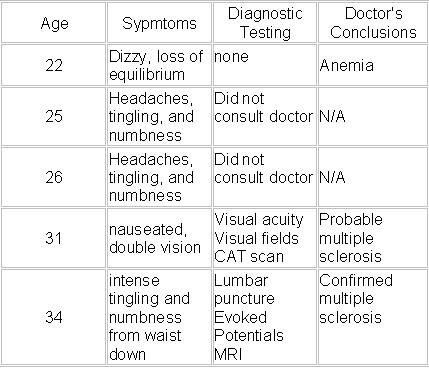|
Case Summary
Instructor's
Note:
Because of the long
time span involved in this case, it is summarized here in table
format.
 1.
Multiple sclerosis (MS) is an autoimmune disease in which
the body's immune system attacks the myelin sheath surrounding
the nerves in the central nervous system. Although some of
the myelin may be repaired after an attack, myelin may also
disappear and characteristic scarring may form (plaques).
Demyelination of the nerves slow or may actually stop nerve
impulses. 1.
Multiple sclerosis (MS) is an autoimmune disease in which
the body's immune system attacks the myelin sheath surrounding
the nerves in the central nervous system. Although some of
the myelin may be repaired after an attack, myelin may also
disappear and characteristic scarring may form (plaques).
Demyelination of the nerves slow or may actually stop nerve
impulses.
2. The
alteration of nerve impulses may cause varied symptoms.
Janet's symptoms included fatigue, dizziness, visual blurring,
and sensory disturbances including tingling and numbness.
As Janet's disease progressed, her motor skills became impaired
causing partial paralysis and leaving her with an awkward,
shuffling gait. In advanced multiple sclerosis, symptoms
may included bladder dysfunction and mental impairment.
3.
MS can be a difficult disease to diagnose. Characteristic
plaques may not appear until the disease has progressed for some
time. The diagnosis is based upon the patient's history and
symptoms, elevated proteins in the CSF, slowing of nerve impulses
detected by evoked potentials, and MRI results showing lesions or
plaques in the spinal cord, brain stem, and/or cerebral cortex.
4.
Steroids or antiinflammatory drugs are used to shorten the
duration of acute attacks. Beta interferons such as Avonex
are used to suppress the body's immune response to decrease the
attack against myelin. Supportive therapy for individual
symptoms is given as needed.
5. There is no known
cure for Multiple Sclerosis. The average duration of the
disease is 30 years.
6.
There is no known prevention for Multiple Sclerosis.
Research supports the theory that there is a genetic
predisposition to MS which is triggered by an environmental
factor such as a virus.
7.
A person with MS may see varied health professionals depending
upon their symptoms. In Janet's case, her ophthalmologist
first suspected MS and referred her to a neurologist who made the
diagnosis. Several key health professionals performed the
diagnostic testing crucial for diagnosis. These
professionals include clinical laboratory scientists who
evaluated the cerebral spinal fluid, and radiological technicians
who performed the cat scan and MRI. The radiologist read
and interpreted both the cat scan and MRI. Nursing care, in
this case, was provided by a home health care nurse. These
nurses provide services to individuals in their homes, often to
the elderly and those that are homebound. In this case, a
home health care nurse assisted Janet during the severe attack
that left her unable to walk. Later, the nurse visited
weekly to administer medications. The home health link describes
requirements for this field as a bachelors degree in nursing.
This is required for certification but it should be noted that
RN's and LPN's also work as home health nurses.
|